UPDATED! This post on the brands with the best content marketing campaigns has been updated for 2020.
Advertising still works, but not as well as it used to because, in part, 47% of Internet users globally use an ad-blocker today.
So if interrupting users with your ad message doesn’t work as well, how can you get them to actively seek out your product or company? The answer is content marketing.
Content marketing is an aspect of digital marketing that focuses on creating and distributing valuable content such as blog posts and videos to acquire new customers.
Since marketers who prioritize blogging efforts are 13X more likely to see positive ROI, it's easy to understand that content marketing does more than just drive traffic.
Unfortunately, a lot of marketers start a content campaign and find that it never grows or drives much traffic. Why is that? Well, content marketing isn’t as easy as it used to be. It often goes well beyond writing blog posts or creating a simple video.
The best way to learn how to implement a content marketing campaign that actually works is to study the brands that have been successful at it.
That’s why we pulled together some of the best content marketing examples from companies around the world. Read on to deep dive into the strategies they used, why it worked and how you can duplicate their success.
Book My Free Content Marketing Consultation
1) Orbit Media
Orbit Media may be “just” a web design and development agency, but their content marketing is truly unparalleled. The website brings in nearly 60,000 visits per month with zero ads and their success lies in the originality of their content:

While their guides are comprehensive and well written, they also do a lot of original research. For example, every year they send out a survey to 1,000 bloggers and then curate the data into statistics which are transformed into branded images, charts and more. Just that one post has over 4,000 backlinks!
And it’s not just Orbit Media that believes in the power of original research: 94% of marketers agree that original research elevates a brand’s authority.
In addition, their CMO, Andy Crestodina, is quick to catch on to trends and create new statistics around them. For example, when the COVID-19 pandemic hit, he was one of the first to share original research around how it would affect agencies:
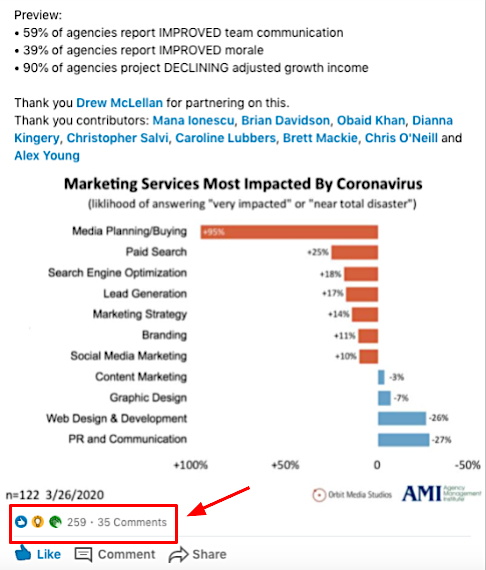
Although some of these research projects can be expensive, not all of them are.
For example, Crestodina once wanted to know the average lifespan of a website. The statistic didn’t exist at the time, so he hired a virtual assistant to go into the Wayback Machine (an Internet archive of more than 424 billion web pages saved over time), complete a few calculations and within a few days found that the answer was: 2 years and 7 months.
When he published the article, the statistic earned over 300 backlinks and only cost the company a few hundred dollars to hire the virtual assistant.
Finally, Orbit’s CMO also does a lot of collaboration which not only helps the company achieve more original research, but it also helps develop relationships with real people. These relationships lead to podcasts, speaking gigs and numerous other opportunities to further Orbit Media’s brand presence.
Takeaway Tip
Invest in original research and consider having a spokesperson for your company. This can be as simple as calculating a statistic yourself or as complex as doing a collaboration with, say, a software company with complex data.
You can also leverage collaboration as a double-edged sword by not only building relationships with the people that you work with directly, but also by leveraging their audience through speaking and podcast opportunities.
Dive Deeper: Absolutely Everything You Need to Know About 10x Content
2) Investopedia
If you’ve ever Googled a question related to financial investments, you’ve probably come across Investopedia. Their content strategy is so powerful that it brings in over 33 million visitors per month:

There are two standout reasons for this:
- They create an amazing content architecture that satisfies search engines and users
- They make complicated topics easy to understand with real-world examples and concise explanations written in plain English
First, let’s take a look at their content architecture.
They use the hub-and-spoke model for all their broader keyword pages (hub) which link to the spokes. Below is an example of this content model where an article about a broad topic (supply chain planning) links to several sub-topic posts (like sales and R&D):

Here’s a great example of a hub page on capital gains that starts out with a table of contents linking to the various sub-topics within the post:

As you reach each subtopic, you find a short and concise explanation (written in plain English) with links to an in-depth page for each sub-topic (long-term and short-term capital gains):
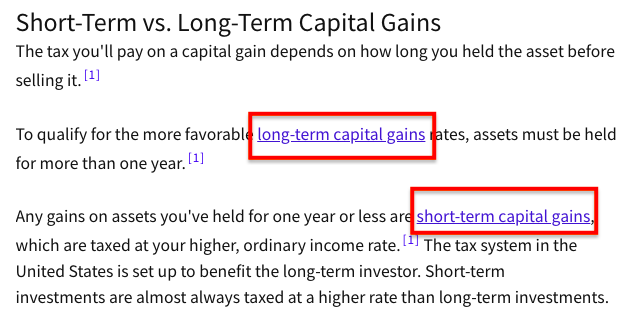
The links create a great user experience by keeping the explanation short and concise for readers who already know what the term means, but giving those who don’t know a chance to read deeper. Google also rewards this kind of internal linking.
However, it isn’t just on their hub pages where they leverage internal linking. If you click into the subpage, long-term capital gains, you’re brought to another page that also leverages internal linking:
Aside from their content structure, they take a complex and imposing topic and make it easy to understand.
First, under each opening paragraph, they include a “key takeaways” box that allows the reader to get a snapshot of the post:

They also include hypothetical examples to further explain their point:

Just to drive home any examples they create, they also illustrate those examples with charts and images:

This helps make the once complicated topic easy for anyone to understand and by creating a better user experience, they’ve been able to dominate the industry through content marketing.
This simple approach has helped them earn over $70 million per month in traffic value without paying a cent to Google!

Takeaway Tip
Create a strong content architecture. Think about how you can structure your content into hub-and-spoke models and then further interlink the spoke pieces.
In addition, don’t overlook the power of simplicity. If you’re in a space with a lot of complex information and terms, such as a data, financial or medical industry, think about how you can present your content in the most simple form possible.
Dive Deeper: How to Design the UX of a Website or App to Increase Conversions
3) HubSpot
HubSpot is one of the companies with the strongest examples of content marketing. They were one of the earliest adopters of content marketing and have built an incredible customer journey that helps bring prospects to the point of purchase when they are ready.
Many marketers focus on cranking out content with the hopes of bringing in more traffic, but only about 41% of B2B marketers think about how they can move customers towards the sale when creating content.
So what does HubSpot do? They have a very wide funnel and, similar to Investopedia, they have blog articles for very broad topics like “sales strategy”:

As people move down the funnel, they offer more detailed content such as “speed up content creation”:

At the end of a lot of these posts, they include a CTA to try their free software:

Even if the person doesn’t convert to the free software, they make an effort to at least collect their email with a pop up (and even include another CTA!) to remarket to them:
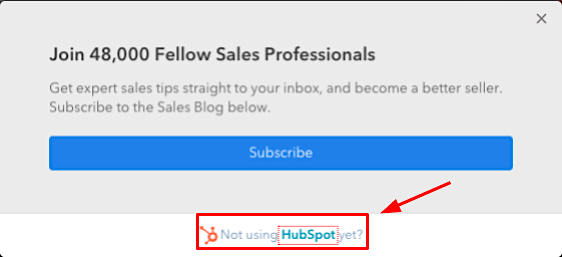
In addition to the entry-level content, they also have guides and tools available on their resource page. For example, if I want to download the SEO On-Page Template, I have to give them my email address:
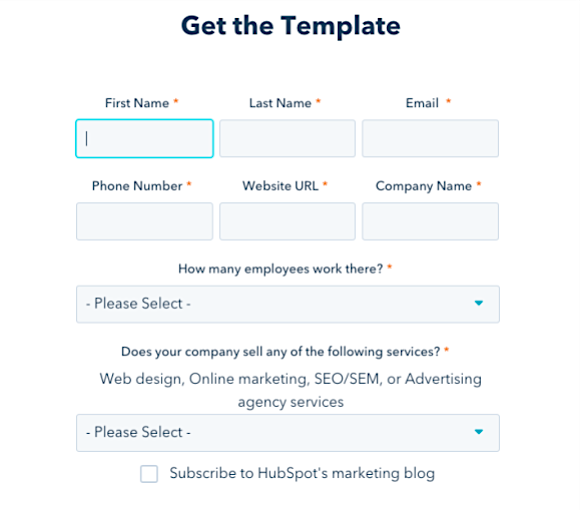
Once I download the guide, I’m presented with a thank you page which shows me an offer about their free software:
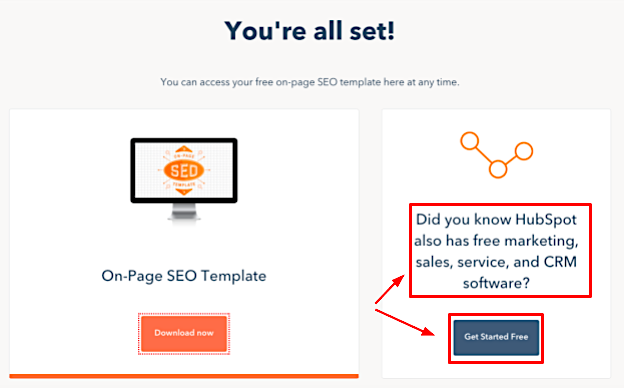
If that wasn’t enough, I’m then sent an email with an offer to get on a sales call: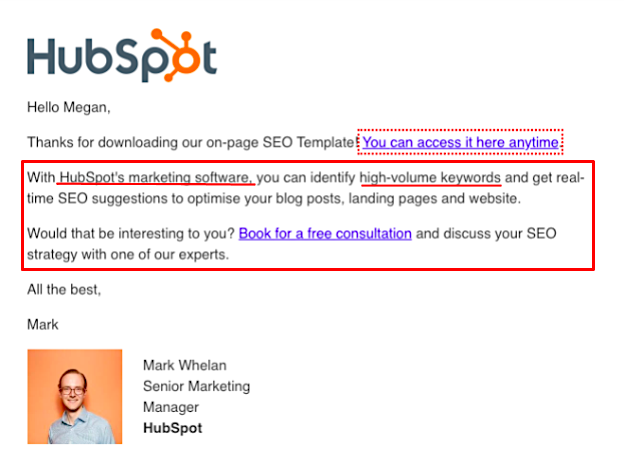
The offer itself is also tailored to the download that I made – an SEO template.
HubSpot is a master at selling through content. While many of the broader keywords don’t have any CTA at all (other than the pop up asking for your email address), they build trust with you first and provide a lot of value upfront before pulling you into the funnel.
It’s very important not to sell too early as 80% of buyers view over five pieces of content prior to making a purchase decision, though it is important that you plan a funnel and pull them into it when the time is right.
Dive Deeper: How to Create the Ultimate Marketing Funnel (Templates Included)
Takeaway Tip
Put a plan in place to start pulling people into your funnel through your content. Don’t let your traffic leave your website without getting an email address.
Offer a CTA at the bottom of your broader posts, offer higher level gaited content in exchange for an email address and leverage free tools to pull the audience into an email sequence that pushes them to a call.
Book My Free Content Marketing Consultation
4) Jay Shetty
After returning from India where he was previously a monk, Jay Shetty struggled to find a job. He wanted to share the personal growth lessons he had learned as a monk in a new and entertaining way and eventually created his own videos.
His content was so unique and inspiring that it was eventually picked up by Ariana Huffington and within just a few weeks he was on his way to being one of the most inspirational personal development speakers. He now sells coaching programs and has over 20 million followers – and he grew all of this through content.
Why was his content wildly successful? There are two main reasons.
A) He Took a Unique Angle
Regardless of whether or not Ariana Huffington had picked up his stories, he would have been successful anyway because his videos take a unique approach: storytelling.
According to Joe Lazauskas, the author of Storytelling Edge, stories have been proven to increase neural activity in our brain fivefold which eventually leads to a much higher engagement rate.
So how does Shetty leverage storytelling?
His videos begin with a highly relatable scenario that hooks the reader. His early videos would usually begin with a tale or news story, but his later videos even used actors to act out a scenario.
For example, this video below opens with a man who is fired from his job. Two years later the boss runs into him on the street and the man now has his own company, an expensive car and is much happier. At the end of the video, Jay Shetty explains that sometimes when things don’t work out, such as getting fired, it’s actually a blessing.
The second half of each video is Shetty explaining the moral of the story and giving the viewer actionable advice. His unique background as a monk also gives him a fundamentally different point of view than an average psychologist, therapist or personal growth coach and he has a truly captivating form of speech.
B) He’s Omnichannel
Shetty’s content also appears seemingly everywhere. He has a consistent posting schedule on Facebook, Instagram and YouTube, and he also hosts a podcast where he brings on world-renowned guests like Kobe Bryant, Brendon Burchard and Dean Graziosi.
He takes his content offline as well, speaking frequently at conferences and even writing a book. He repurposes most of his content which makes it possible for him to have a very efficient team of under 20 employees.

![]() Takeaway Tip
Takeaway Tip
Think about how you can incorporate stories and draw from your own past experiences to hook people into the message you want to share. The best content marketing examples all include repurposing as well to build a strong presence across multiple platforms with a small and agile team.
Dive Deeper: 7 Examples of Storytelling Content You Can Use in Your Marketing Campaigns
5) TED
TED is a set of global conferences where authors, experts and other leaders give short talks about thought-provoking ideas. TED has had significant growth as a result of their amazing free content.
Check out their YouTube page — they’ve got over 16 million subscribers who get every single video update:

Most of their videos have tens of millions of views, and that’s not even counting their TEDx, TED Fellows, TED-ed, and other channels:

The reason that TED does so well is that they’re committed to creating “ideas worth spreading.” So how did the TED videos catch on?
First, they bring on only the very best speakers with truly engaging ideas. TED originally was an invitation-only conference and the organizer of the event was known to send people off stage during their presentation if he felt it wasn’t good enough. The high-quality standards have since attracted speakers like Elon Musk, Tim Urban, Tim Ferriss and many more.
At the end of the day, TED isn’t focused on SEO or market research. They’re focused on their main priority — finding and creating world-class content they think people would love. This is why they’ve become such a global sensation, even though most of their content is comprised of 15-minute videos of someone talking on a stage.
Finding and recruiting world-class thinkers to help contribute to your content is one of the best ways to build an audience. If you are just starting out, consider niching down and find an expert on one very niche idea. You can start by interviewing them on a podcast and later turn those podcasts into blog posts, emails and more.
Another reason why TED is so successful is that they were an early adopter of trends. While blogging was previously the most popular form of content, video has now overtaken that spot as the most popular form of content:
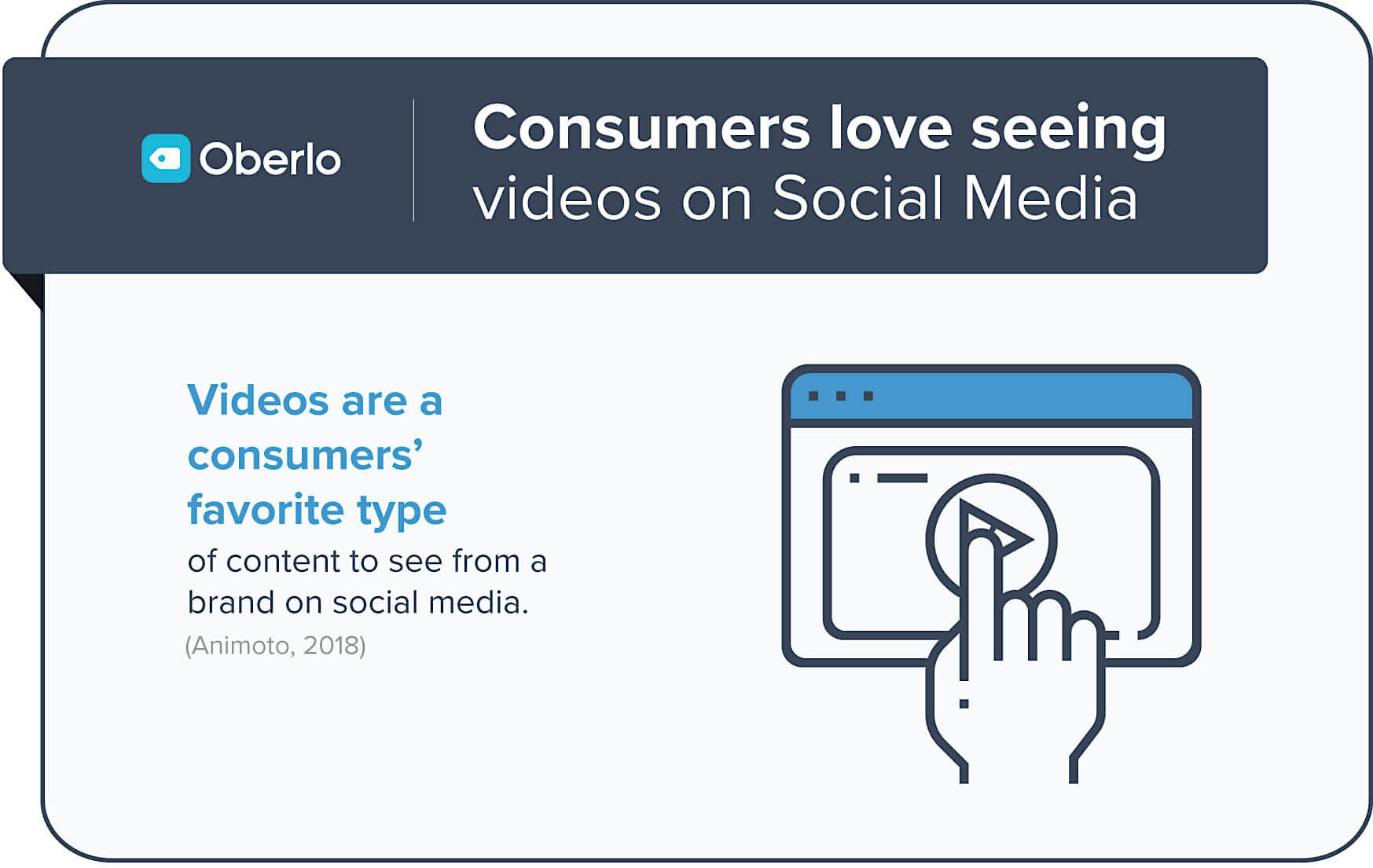
In addition, TED realized the importance of free content and how useful it can be to build a brand.
They started by releasing just six talks in June of 2006, and by September they had reached one million views. After noticing how valuable the free content was to the brand, they began simulcasting the spring conference and by 2009, it had over 100 million views. In the fall of 2012, TED Talks celebrated its one billionth video view – with an average of 17 new page views per second around the world.
Takeaway Tip
Think about how you can attract thought leaders and get them on your platform (start with a podcast). If you’re brand new, niche down and as you grow you’ll get bigger and bigger influencers. Also, take note of the latest digital trends and don’t wait to try them out.
Dive Deeper: Omnichannel Marketing: Using the Content Sprout Method to Overcome Info Overload
6) Wistia
Wistia provides companies with professional video hosting and video marketing tools. So it’s no surprise that their content creation process is successful.
Their Learning Center includes a variety of up-to-date content that's relevant to their audience’s pain points – though it doesn’t look anything like a standard resource page with white papers and boring blog posts:
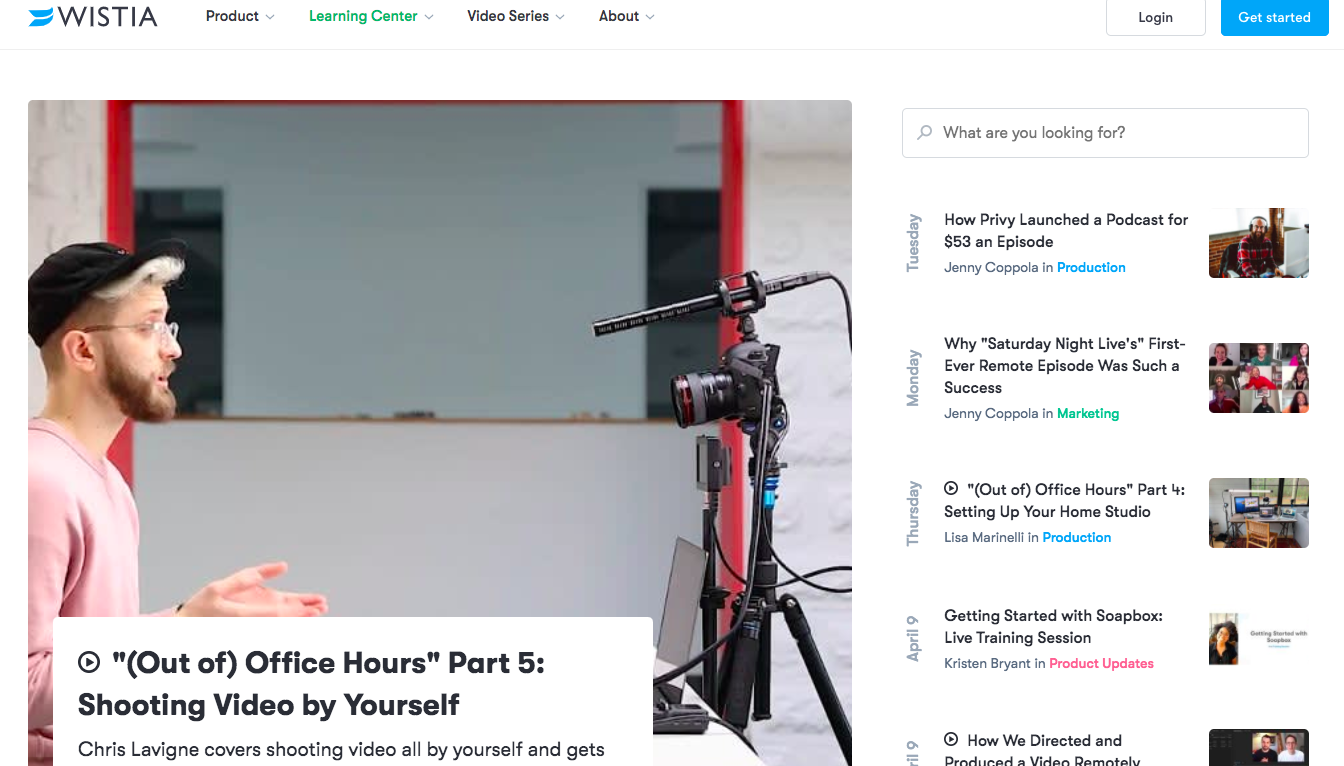
Instead, Wistia always manages to take a unique, Netflix-like approach to content marketing that indirectly showcases its product (video software) and provides actionable advice with an added dose of humor.
For example, their latest content marketing approach is a mini TV series called Brandwagon. The show, while humorous, provides great insights into building a brand with the company’s CEO, Chris Savage. The popular media format and humor draws people in, but the expert advice keeps the ideal target audience hooked:

Another approach that they take is doing, essentially, a research project, but it's shot and edited to look more like a documentary series. For the experiment, One, Ten, One Hundred, Wistia hired one video agency to make three different videos and the only variable was the budget: one would be a $1,000 video, the second a $10,000 video and finally a $100,000 video:

Couple these unique and captivating forms of video content with the fact that video drives 66% more quality leads and it’s a sure win.
In addition to their video content, they also create original research, often leveraging the video statistics that they already have in their customer database. For example, they created a case study around video CTAs where they analyzed the location, copy and other elements from over 3.6 million video CTAs. This research was 100% unique and provided actionable insights to their target audience: people creating videos.
It also helped them gain over 400 backlinks and cost them nothing to produce:

Takeaway Tip
Think of a unique medium that you can present your content in. For example, if you're in the B2B space, consider transforming your content into a TV format. In addition, learn to leverage the unique assets that your business has. That could be the CEO’s insights into your niche or data that you’ve collected over time.
Dive Deeper: 20 Pre-Production Tips to Create Successful Video Content in 2020
7) Canva
Canva is a unicorn startup founded in 2012 which now has a valuation of $2.5 billion and over 15 million users. It allows marketers to create beautiful and professional-looking designs like infographics, charts and blog images for free:

They make money by offering premium icons to use in your ads, but there are still plenty of free icons to create an amazing design for free:

Their winning content marketing campaign is user-generated content and product-led growth. The tool is so valuable that Canva doesn’t really need to market it.
To amplify their growth, they leveraged influencer marketing and brought on Guy Kawasaki (a marketing specialist and venture capitalist who was one of the employees responsible for marketing Apple's Macintosh computer line in 1984). He was a huge fan of the tool and when the Canva team found out, they connected with him and he eventually became their Chief Evangelist.
In this case, their defensible moat is the product itself because even in an economic downturn, it will actually probably grow as the alternative is usually more expensive: hiring graphic designers.
Takeaway Tip
Create a tool or freemium version of your product that is so valuable that your audience will share it without even being asked. To really amplify your reach, connect with influencers to help spread the word.
Dive Deeper: The Ultimate Guide to Growing Your Business with Influencer Marketing
8) GoPro
GoPro is a manufacturer of action cameras that are mostly used in adventure sports.
These cameras are usually used by their customers in dangerous or envy-inducing locations, so it isn’t difficult to encourage them to share their videos and thus the product. And they’ve run with the idea of letting the product advertise itself through user-generated content (UGC). The best part about UGC is that 79% of consumers say it highly impacts their purchasing decisions.
Very little of the GoPro brand content is created solely by GoPro themselves. It’s often well-edited video compilations of users doing whatever activity they’re interested in with their GoPro.
They took the UGC idea to the next level by creating a Million Dollar challenge. Essentially, people submitted their adventure videos for the chance to win a million dollars. GoPro used the winner’s video to create a marketing campaign and it was wildly successful, not only by encouraging users to share their videos but also by creating free marketing content.
Their YouTube channel is filled with compilations of other extreme sports. Not every video is going to resonate with everyone, but they certainly grab the attention of similar users – so much so that GoPro recently celebrated 2 billion views on their YouTube channel!

Their content goes viral consistently because people can either live vicariously through the videos that GoPro publishes or are able to use them as inspiration for their own extreme adventures. Not only that, but because it’s user-generated, it costs almost nothing to produce.
Dive Deeper: 8 Ways to Encourage More User-Generated Content (UGC)
Takeaway Tip
Your users aren’t just potential customers, but advocates and brand ambassadors as well. If you can get them to help produce marketing collateral, you’ll massively increase reach and social proof with little effort.
Book My Free Content Marketing Consultation
9) Hotjar
Hotjar makes heatmaps for websites. It tracks where on the web page users have visited and what they clicked on and moused over.
Even though they’re just a SaaS company, they have an incredible content marketing strategy that brings in over 180,000 visitors per month:

So why is it so successful? For one, they created an amazing hub-and-spoke piece devoted entirely to heatmaps:

This piece ranks for just about every single keyword related to heatmaps, both broad and long-tail:

In addition, even though they have a very strong domain authority, they still focus on long-tail keywords. For example, they still do comparative “Hotjar vs. competitor X” posts and explain the difference between their service and a competitor. It’s very useful for potential customers, and Hotjar can own the explanation.
Think about how many times you have compared software that was seemingly the same? You can’t see a difference in the two so you end up just picking the one that is cheaper. This is where Hotjar excels.

The good news is that long-tail keywords also have a much higher conversion rate:

Therefore, even if you feel that you do have enough authority to win broad keywords, stick to long-tail keywords that convert better. Long-tail keywords make up the majority of searches anyway.
Takeaway Tip
When you start building your content, start with a hub-and-spoke model to capture all the relevant keywords possible for your main term. For example, if you sell a bookkeeping software, create a hub-and-spoke piece around “bookkeeping.” From there focus on long-tail keywords and make sure that you own the “your company vs. competitor” keywords.
Dive Deeper: Why You Should Use Long-Tail Keywords in Your SEO Campaign
10) I Will Teach You To Be Rich
Ramit Sethi, the founder of I Will Teach You To Be Rich, is one of the most frequently referenced experts of email copywriting.
While he’s celebrated for his email copywriting, the real ingenuity lies in his customer research. As only about 40% of marketers actually do customer research, this is a huge opportunity:

Before pitching any product to his list, he talks to his customers to see if it’s something they actually want and are excited about.
For example, he had planned on adding a feature to his course that gave members access to a list of contractors that I Will Teach uses. It sounded like a great idea, but it turns out that people weren’t that excited about it. This was an exact answer he received from one of them:

He also writes down the exact language they use. For example, if you are selling a marketing course to doctors, don’t use the term “customers,” use the term “patients.”
In addition, he uses the exact emails that prospects emailed to him with their objections. Rather than letting those objections prevent the prospects from buying, he sends them an email showing them why it’s not a valid objection. Here’s an example where he was selling a course to help people start their first venture:

There were surely a lot of other people who had this objection and by bringing it front and center, he could address it for all skeptics.
After doing thorough customer research, he infuses it into his omnichannel content marketing campaigns which are comprised of video, blog posts, podcasts and a lot of email marketing. In fact, this tactic is what helped him generate a $5 million launch in just 6 days!

Takeaway Tip
Any truly brilliant marketing campaign must start with thorough customer research. Just because you think that something is a great idea doesn’t mean your customer will pay for it. Talk to them before marketing anything to them and then swipe the exact language that they use.
Dive Deeper: How Bestselling Author Ramit Sethi Generated $5M in 6 Days (podcast)
11) Glossier
Glossier is a beauty brand that takes community to a whole new level. Their Twitter followers are advocates of the brand so that the company rarely has to do any marketing itself.
Unlike GoPro, who offered a product that promotes itself, Glossier built a loyal following by interacting with Twitter users in a very personal way. In fact, if you look at their Twitter page right now, it looks like a conversation between two girls geeking out on makeup products, not a company doing great marketing:

Notice that most of their feed consists of fan retweets. This reduces the workload on the content team as they don’t have to create more posts; plus it provides amazing social proof in a fun way.
Glossier also understands the value of creating a community that will encourage repeat customers. In fact, just a 5% increase in retention can increase a company’s revenue by 25-95%.
Takeaway Tip
Try creating less content and investing in building customer relationships. Rather than just doing giveaways or “share to win” posts, focus on consistently responding to comments, sharing any brand mentions and turn your social accounts into a community. Don’t take yourself too seriously in the process!
Dive Deeper: Here’s How Targeting Cold, Warm & Hot Traffic Builds Successful Customer Relationships
12) Buffer
Buffer automates your social media posts, which makes it easier to share content. Content marketing is Buffer’s main growth strategy, and their posts show it. Check out the engagement these posts from 2019 received:

In an interview in 2019, CEO Joel Gascoigne said that they “explored a bunch of different channels and found content marketing which was really the thing that eventually got early growth. And even today is a huge channel for us.”
Creating content and building a following by purely growing your own blog will take years. Therefore, the founders of Buffer did something unique – they created nearly 150 guest posts across relevant blogs and it skyrocketed not only their traffic but also got them their first 100,000 customers! In fact, they went from 0 to 100K in 9 months!
In fact, the founders at Buffer were originally rejected from publications like TechCrunch and Mashable. After Buffer’s guest blogging strategy worked spectacularly well, though, their app was covered by both of those publications.
After gaining some initial traction, they carried content marketing over to their own blog and today they write popular in-depth blog posts and even launched a podcast:

We all know that it takes a lot of time to get results through content marketing, but one of the best ways to speed it up is by guest posting on other high-traffic sites.
Dive Deeper: The Power of Guest Blogging (And How to Get Started!)
Takeaway Tip
We don’t all have an established audience. Instead of trying to grow from nothing, take the path of least resistance and use guest posts to get your best content in front of your ideal customers.
Book My Free Content Marketing Consultation
13) Intercom
Intercom helps companies communicate with their customers more efficiently. One of the things that they do particularly well is repurpose content.
For example, they have a podcast that addresses key marketing and business topics. Once an episode is recorded, they repurpose everything they can. Take this piece for example. On that one page you have:
- A recording of the podcast itself with a brief description of the episode:

- A number of quick takeaways that address the main points:

- A full transcript of the piece that has been nicely designed to include standout quotes and relevant images:

They basically turn a single piece of content into a multi-use asset. Using your core content to create spin-off pieces gives you a much better chance to rank on page one of the SERPs.
Intercom also does a good job of using images and graphics in the right places within a blog post to add more value, or certainly more quality. For example, in this piece on chatbots, they offer a GIF to show how it works:

Takeaway Tip
Consider how you can create less content, but push it to more channels. Take a single piece of content and repurpose it to your blog, social media, videos and more to meet your audience at their preferred channel.
Dive Deeper: The #1 Marketing Strategy for 2019: The Content Sprout Method
14) VaynerMedia
Gary Vaynerchuk (or Gary Vee, as he is known as) has produced one of the most incredible content machines of all time – and it’s worked out spectacularly for him. Just take a look at his popularity in Google Trends:

Perhaps what has contributed most to Gary Vee’s success is his ability to embrace new trends (he was an early adopter of social platforms like Facebook and Instagram) and new mediums, such as video.
He started with just Wine Library TV, a daily webcast covering all things wine. When he realized how well it was working, he invested more heavily in it. He later started the #AskGaryVee Show in 2014, where he answers people's questions about marketing, social media and entrepreneurship, and now has the DailyVee show.
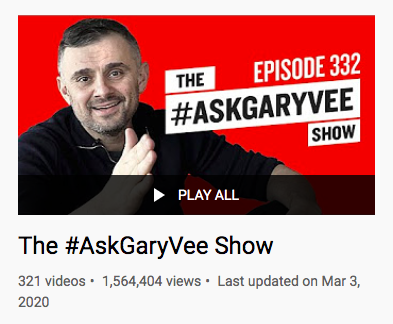
His videos succeed largely because he produces quality content in a format (TV) that people enjoy. Watching TV is much more entertaining than watching another boring video on how hard it is to grow a business. Therefore, he combined the two to create a highly engaging piece of content.
The sheer quantity he puts out also helps increase subscribers. Today, he has cameras that follow him around and record most of his day. The team breaks up these videos into bite-sized pieces and releases multiple videos.
Finally, Gary Vee is genuine in his videos. He swears, he calls people out, and he doesn’t sugar coat anything. This turns some people off, but it also creates a stronger community with his fans.
Takeaway Tips
- Adopt new trends quickly. Gary's adoption of social media in its infancy gave him the upper hand and helped build a following before it was super competitive.
- Video is great for storytelling. You get the full picture of Gary Vee’s life and business in these videos. He doesn’t hide the hard parts and it captivates people.
- Know your audience and be genuine with them. Gary Vee attracts a very particular type of person. His videos often show tough love and he also swears a lot. You may lose some followers, but your fans will love you even more if you’re genuine. While he has a lot of haters, his fans feel that they know the real Gary Vee, not an inauthentic version.
Dive Deeper: The Video Structure that Big Agencies Use to Create Successful Videos
15) Content Marketing Institute
The Content Marketing Institute is one of the masters of leveraging original research. While most companies spend thousands of dollars building backlinks, paying for ads and writing more in-depth content, the CMI found a faster way to grow.
They partnered with Marketing Profs and created the first ever Benchmarks, Budgets, and Trends report an the results were powerful enough to make it an annual fixture in their marketing strategy:

From an SEO perspective, that single piece of content generated about 700 backlinks and 91 of those links were do follow from 50+ DA websites including HubSpot, Adobe, Search Engine Journal, Hootsuite and many more!

However, it's not just SEO and branding value.
The first employee of the CMI, Michele Linn, says that:
“When you look at the editorial stats, at which stats were getting the most traffic and which stats were getting the most backlinks and which pieces of content were getting the most conversions through email, it was always the research.”
Therefore, not only does research generate more brand awareness and establish a company as a thought leader, but it also has a direct correlation with conversions.
Takeaway Tip
Next time you can’t find a statistic to prove a point you're making with your content, think about how you can create that statistic yourself. Sometimes it’s as easy as looking through data that’s already publicly available. If not, partner with a company that can do it for you.
16) Oberlo
KISSmetrics was one of the first companies to popularize infographics and became famous for generating over $16 million in traffic valuation through them. They used to work really well when marketers wanted something to visually represent what their blog content.
However, as infographics became more and more popular, the ingenuity wore off and they don't work quite as well as they used to. They can also be very expensive to produce.
However, Oberlo, Shopify's dropshipping app, has taken a unique approach. Rather than creating infographics, they collect about 10-20 statistics for a topic (say TikTok) and then create original graphics for each statistic (though they usually include a full infographic at the bottom):

When I did a Google Image search, look at how often their images are reshared:

I know that it works, because I’ve used their images on multiple occasions here on the Single Grain blog.
Takeaway Tip
Original research can be a long and tedious process. Instead of doing your own research or even creating a full infographic, consider just creating images for statistics that already exist on a topic. For example, if you did a hub-and-spoke model on “heat maps” like Hotjar did, consider making another page on “heat map statistics,” and create original images for each statistic.
17) Spotify
Spotify is a master at customization.
They offer customized emails, playlists and even a data-driven microsite celebrating each user's individual listening habits. Everything about Spotify is personalized and in 2018, they launched their first “Wrapped” campaign where users received an email that showed them their most listened to music in a story-like fashion:
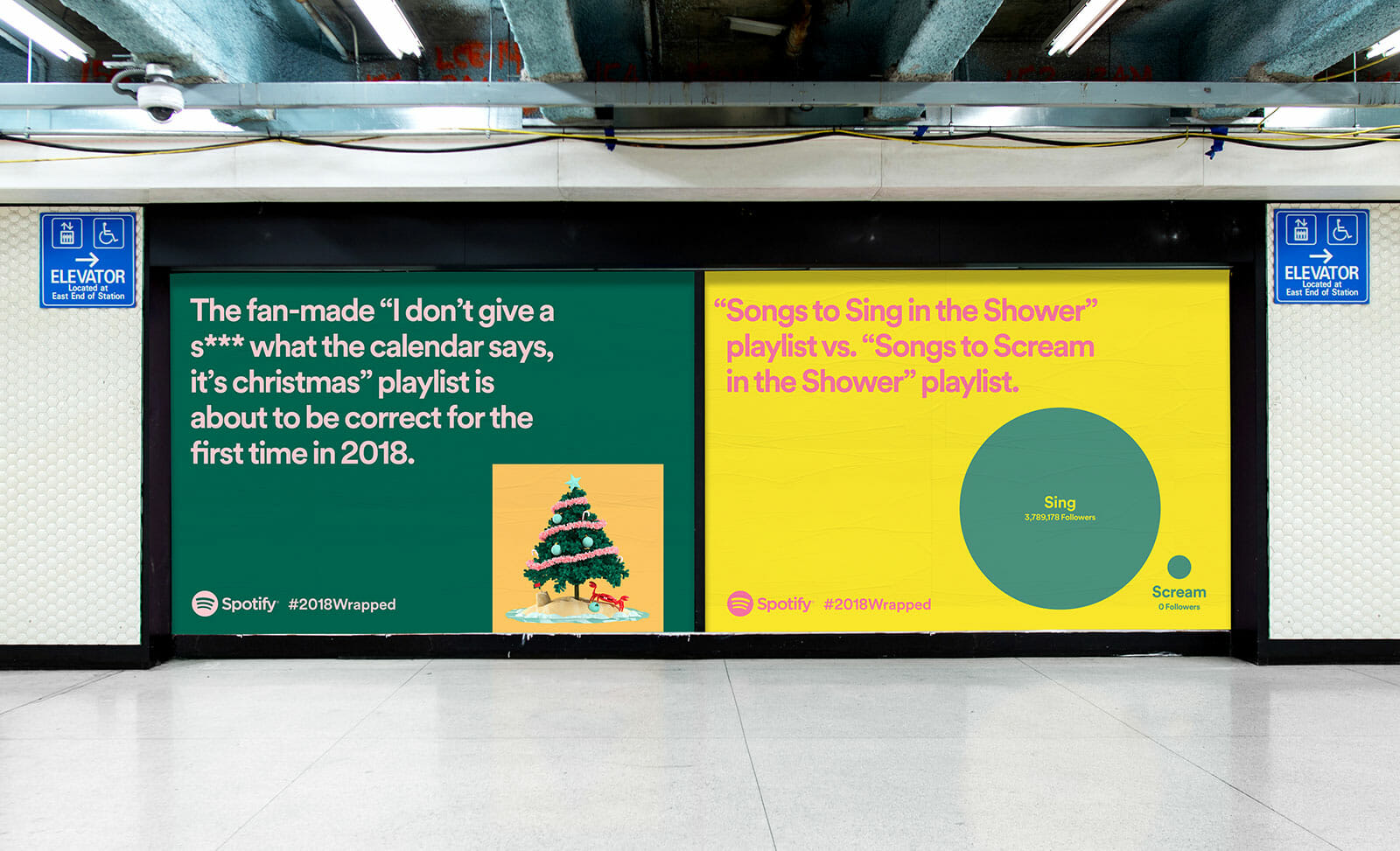

After its initial success, a new “Wrapped” campaign was launched at the end of 2019:

This one featured a story-like campaign from the past decade, expanded to include podcasts, and was made shareable. This is a great way to re-engage users.
Takeaway Tip
Customization is the best way to increase engagement with your audience. If you can customize based on user action, perfect! If not, try to look at the problems that small segments are experiencing and how you can tailor content to their needs.
Dive Deeper: How to Use Personalization to Increase the Impact of Email Marketing
18) Grammarly
Grammarly is a spelling and grammar checker and plagiarism detector. The sophisticated software uses machine learning to improve itself by using data from users’ common mistakes:
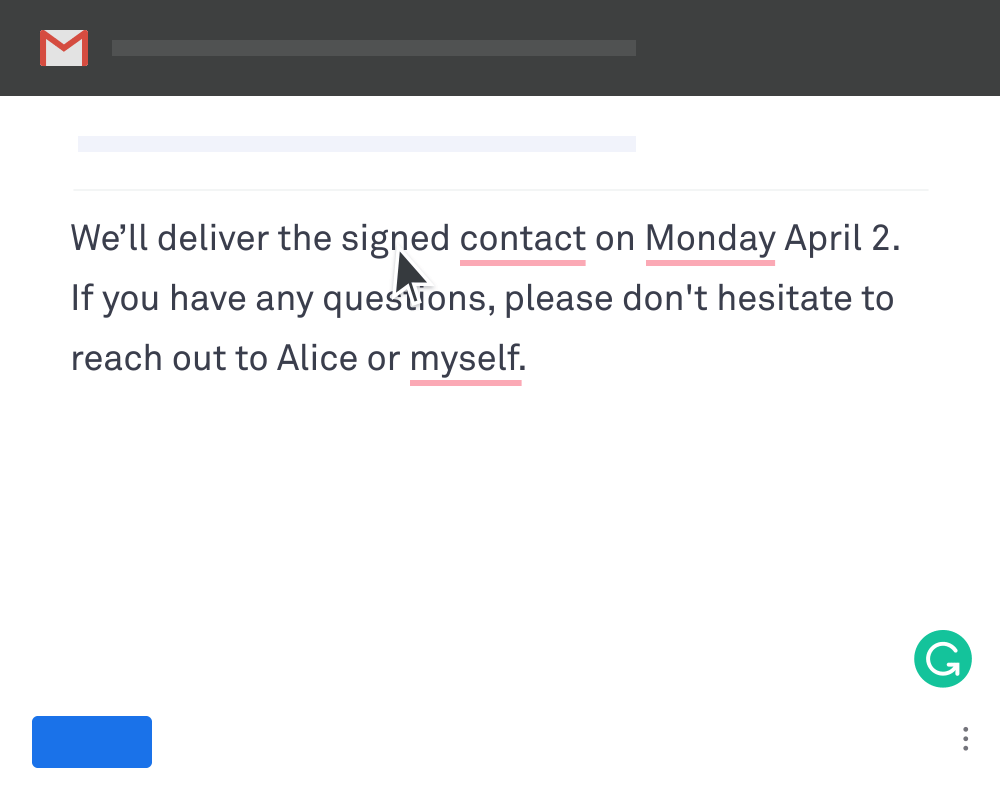
Grammarly puts a lot of focus on customer retention. In fact, a lot of their blog posts focus on teaching users how to make the most out of their product, which keeps them engaged and continuing to pay the subscription.
But the app also teaches people to be better writers. When the app underlines something with a red line, it tells you why you made the mistake that you made. (And I’m willing to bet that you probably are making some mistakes that you never even knew about!)

In fact, if you click on the three dots in the explanation, it will even give you examples of the problem and resolutions:

Grammarly sends out a weekly progress report to customers to offer insights into Activity, Mastery and Vocabulary, like this one that I received:

These stats are easily sharable and it helps increase social engagement as well. In addition, they give you a summary of the top mistakes you should work on:

Dive Deeper: 7 SEO Copywriting Tips to Increase Your Rankings in 2020
Takeaway Tip
Think about how you can make your product or service both fix your customer’s problems and educate them. Creating content that gives users the ability to not need your tool, service or product may seem counter productive, but it builds your authority and user trust in you. You’ll also find that most users will still use your services as a shortcut to success.
Book My Free Content Marketing Consultation
19) Headspace
Headspace is a meditation and mindfulness app designed to help people maintain focus, avoid overthinking, and live a more peaceful existence.

Video meditation sessions are offered via a mobile app and YouTube, and articles on the topic are shared on the brand’s blog, The Orange Dot:

All the articles feature fun and eye-catching illustrations that grab readers’ attention and make meditation and mindfulness less intimidating. They invested in great design that is similar across all their channels, from blog post images to YouTube animations.
They have a decent amount of blog traffic (though that isn’t where their real attention comes from):

Their YouTube animated explainers get anywhere from a few thousand to a few million views each and users are actively engaged and love them!
For example, this video has achieved over 120 million views:
So why do their videos do so well?
Similar to working out, most people are intimidated by the prospect of meditating. Where should you start? How does it work? And after sitting down cross-legged, what are you supposed to do?
They break it down into easy, step-by-step processes and also provide interesting videos explaining why people experience certain thoughts:

In addition, they’ve also leveraged influencers and have done livestream meditations:

The quality of content and consistency of branding has helped Headspace grow to over $100 million ARR, demonstrating the power of good, meaningful content.
Takeaway Tip
Produce a product that solves a problem that a lot of people struggle with. Once you have that product, maintain brand image and voice across all channels, especially if you’ve put the time and effort into building something unique. It just makes it easier for your users to recognize your unique brand.
Dive Deeper: The Complete Guide to Brand Building (Must-Read for Digital Marketers)
20) Blogilates
Perhaps one of the most popular fitness groups on YouTube, Blogilates is an online POP Pilates, PIIT28 and fun bootcamp sculpting instruction course. In fact, the owner, Cassey Ho, currently has over five million subscribers and most of her videos receive 6-figure views within the first week of its release: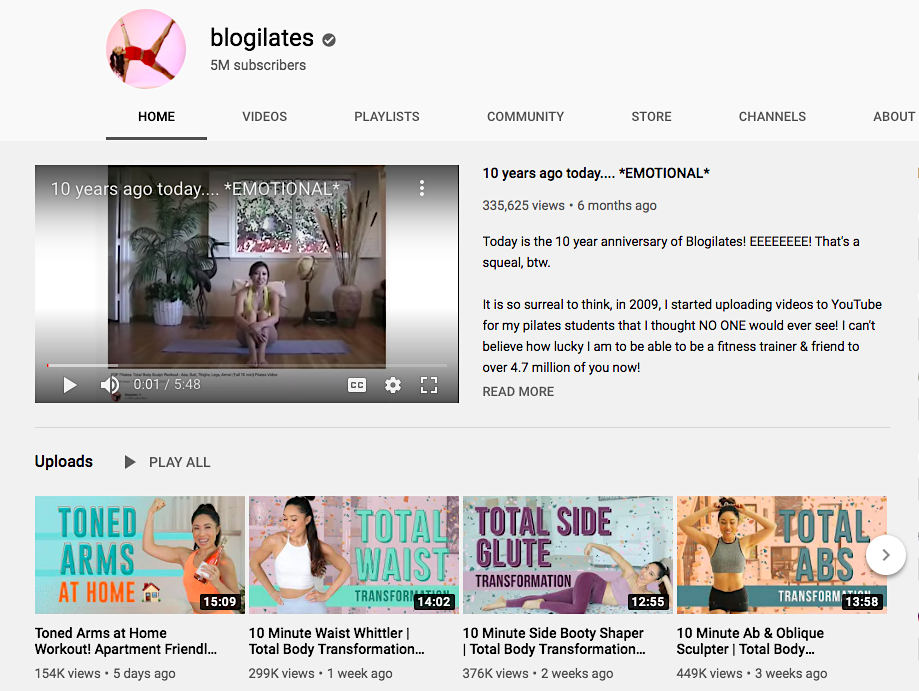
So how did she create this following?
She creates a lot of free (and very high-quality) content that has a life-changing impact on people. In fact, when you go to the website, there aren’t any direct CTAs and very few of her videos have CTAs:

So think about how you can create truly life-changing content and give it all away. Building a bond with your audience first helps increase customer retention and reduces refund requests.
In addition, she has a unique approach to working out. She doesn’t appeal to people who want to work out for aesthetics; rather, she appeals to people who just want to feel better and live a healthier lifestyle. By taking a unique perspective, she stands out from the rest of the workout channels and attracts people who are more likely to be lifelong customers.
Takeaway Tip
If you provide something truly useful to your audience, engagement will go through the roof. Then leverage your most loyal users by setting up a premium version of your product. Focus on value and helping your users above all else. Do this, and you’ll find that the promotion side of your content will almost take care of itself.
21) IKEA
Swedish furniture retailer IKEA has always approached branding and marketing from a quirky perspective. Aside from its excellent IKEA Ideas blog, it also provides compelling examples of how to engage users with content by using the latest technologies:

However, their true genius lies in understanding their customer’s problems. For example, in 2019 the Dubai IKEA found that one of the biggest problems is that it takes a long time for many consumers to get to the store. Their response? They launched the “Buy with Time” campaign.
This campaign allows customers to use Google Maps Timeline to show how long it took them to get to the store. The prices of the items are in time; for example, a chair could cost nine hours. The amount of time required to drive to the store is then deducted from the price.

You know that old saying that gets thrown around a lot?

Check out their 2-minute video ad:
Ogilvy advertising is credited with the idea.
Takeaway Tip
Your customers may not be buying your product for reasons that have to do with the product itself. How can you create a content marketing campaign that solves the core of the problem rather than just trying to make the product look more enticing? In addition, this is a good reminder to do thorough customer research before launching a content marketing campaign.
Dive Deeper: 42 Digital Marketing Trends You Can't Ignore in 2020
22) Single Grain
Every single client that we have – like Uber, Amazon and Salesforce – came from our content marketing.
In 2013, our CEO Eric Siu bought Single Grain from the founders for two bucks (less than the price of a cappuccino!) when it was negative. At that time, the agency's revenue was coming only from SEO services, but with the Google Penguin update, our success formula spiraled and client churn was skyrocketing.
That's when he decided to focus on content marketing.
Today, Single Grain is a content marketing powerhouse, and we are able to maintain this level of consistent, quality output by using the Content Sprout Method, a tactic that starts with one great piece of content (the “seed”) from which you “sprout” new forms of content.
We usually start with a live video which is simulcast to multiple platforms like Instagram, Facebook, LinkedIn and YouTube. We then repurpose that content to our blog, social media, the podcast and other channels.
For example, when we came up with the Content Sprout Method, we did a livestream called “How ONE Piece of Content Can Change EVERYTHING” which lasted about 40 minutes:
This was the seed which then sprouted into a video posted to various platforms like YouTube and LinkedIn. It then also became a blog post:

From there, we also used the audio to post a shorter version to our Leveling Up Podcast:

If you want to try out this technique, here’s a sample schedule you can adopt:
- First, record a Live video of your topic
- Then create three or four shorter YouTube videos from the longer Live video
- Take the audio and turn it into a podcast
- Get the transcript from the video, add captions, and natively post the video on LinkedIn and Facebook (with the time limits, we sometimes shorten the video for these channels)
- Create a 30-second Instagram teaser video linking to the Live
- Use the transcript to to create a 2-3K word blog post
- Once you publish that, make it into an Instagram Story post
- If the subject warrants it, you can create an infographic
So one Live video just turned into 13 pieces of content on five channels.
But it wasn't enough just to create our own content; we wanted to help others learn from our successes and mistakes. So in addition to our blog, we offer:
- Marketing training
- Content marketing training
- ClickFlow, an SEO experimentation tool that Eric co-founded
Takeaway Tip
Make sure to maximize your content efforts while minimizing the work involved so that you can effectively scale your content marketing. That means putting your content in front of your audience, no matter how they prefer to consume it: listening to podcasts, watching videos, bookmarking informative infographics or reading posts and e-books. The Content Sprout Method allows you to publish multiple content formats on multiple platforms to give your audience a multi-channel experience.
Dive Deeper: How to Build a High-Performance Content Marketing Strategy
Final Thoughts on these Content Marketing Examples
Content marketing isn’t just about cranking out content. As the digital marketing space becomes more competitive, it’s imperative that you think of new ways to thrill and offer value to your customers.
- If your stores are in poor locations, maybe you can offer to price your products in hours, like IKEA did.
- If you have a social following, try Glossier’s approach by actively engaging with your customers as if they are your friends.
- Maybe your customers already love your product, like GoPro, so consider how you can turn fans into brand evangelists.
- Or perhaps you don’t have any customers and you’re just trying to grow your blog? Try Oberlo’s approach and create professional looking images for statistics with Canva.
Keep testing various approaches and give each one a fair chance before giving up!
At Single Grain, our content marketing campaigns focus on three distinct phases of content production and promotion: Traffic Generation, Audience Engagement, and Conversions & Profits. If you’re ready to benefit from our knowledge and experience…
Book My Free Content Marketing Consultation
Additional writing by Megan Mahoney.
The post 22 Brands with the Best Content Marketing Campaigns appeared first on Single Grain.
from Single Grain https://ift.tt/2Lkl3fD

No comments:
Post a Comment